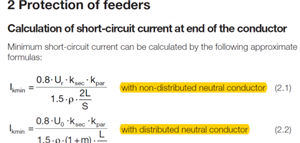(3 Phase + 1 Neutral) loads -- > Is this termed as distributed neutral?
(1 Phase + 1 Neutral) loads -- > Is this termed as distributed neutral?
3 Phase, for example motor --> Non distributed neutral?
2 Phase, for example lighting fixtures -- > Non distributed neutral?,
I would like to apply the relevant equations to find the short circuit at the end of line. That is why this question came up.


